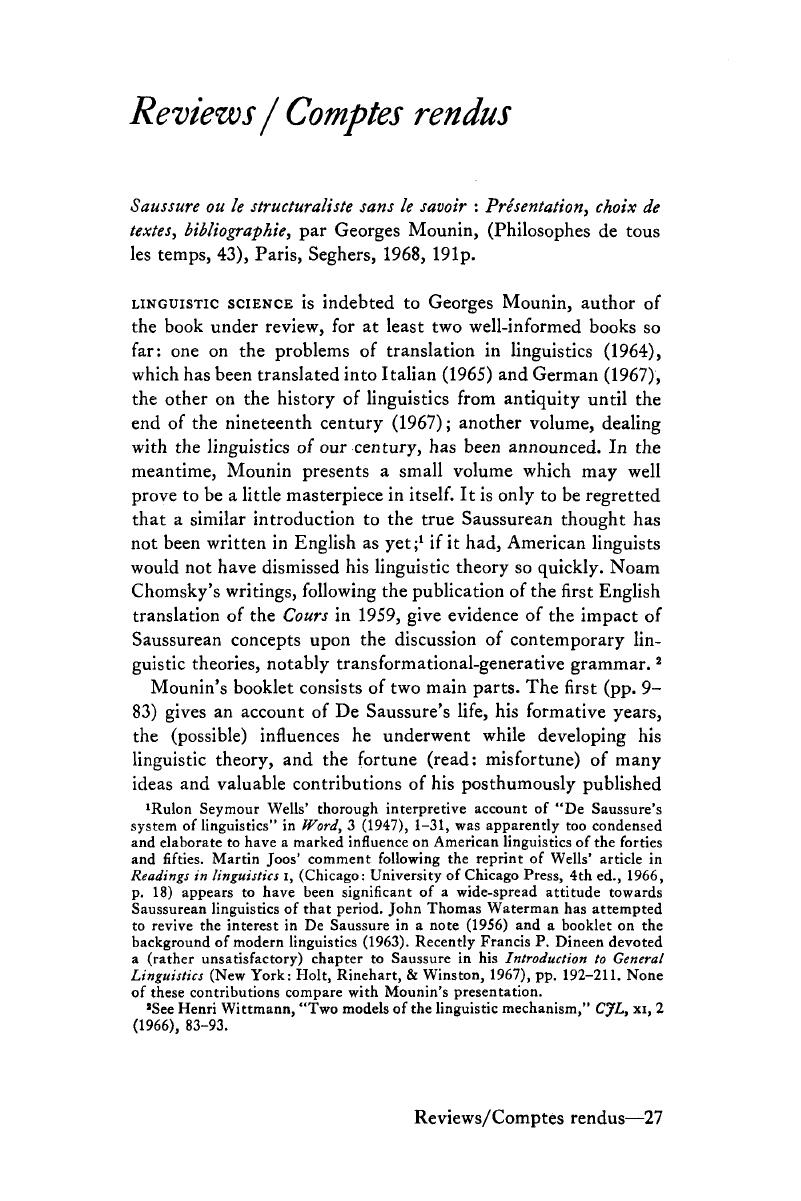No CrossRef data available.
Published online by Cambridge University Press: 27 June 2016

1 Rulon Seymour Wells’ thorough interpretive account of “De Saussure’s system of linguistics” in Word, 3 (1947), 1-31, was apparently too condensed and elaborate to have a marked influence on American linguistics of the forties and fifties. Martin Joos’ comment following the reprint of Wells’ article in Readings in linguistics I, (Chicago: University of Chicago Press, 4th ed., 1966, p. 18) appears to have been significant of a wide-spread attitude towards Saussurean linguistics of that period. John Thomas Waterman has attempted to revive the interest in De Saussure in a note (1956) and a booklet on the background of modern linguistics (1963). Recently Francis P. Dineen devoted a (rather unsatisfactory) chapter to Saussure in his Introduction to General Linguistics (New York: Holt, Rinehart, & Winston, 1967), pp. 192-211. None of these contributions compare with Mounin’s presentation.
2 See Wittmann, Henri, “Two models of the linguistic mechanism,” CJL, xi, 2 (1966), 83–93.Google Scholar
3 See De Mauro, Tullio, “Notizie biografiche e critiche su F. de Saussure”, Corso di linguistica generale (Bari: Laterza, 1967; 2nd ed., 1968), pp. 285–355.Google Scholar
4 Here, on p. 23, a quotation from the Cours is faulty, and should be given in its correct and complete wording: “A aucun moment, et contrairement à l’apparence, celle-ci [i.e., language] n’existe en dehors du fait social, parce qu’elle est un phénomène sémiologique.”
5 Saussure mentioned this French edition himself (Cours, p. 18).
6 The reviewer is presently engaged in preparing a critical account of Whitney’s influence on Saussure for publication.
7 Hermann Paul’s dichotomy, cited on p. 38, should be read “Sprachusus” vs “individuelle Sprachtätigkeit.”
8 The first indication of R. Engler’s activity appears to have been his article “CLG und SM; eine neue kritische Ausgabe des Cours de linguistique générale,” Kratylos, iv, 2 (1959), 119-32. Since Mounin does not list this important work in his bibliography, it should be noted here: Ferdinand de Saussure: Cours de linguistique générale, édition critique par Rudolf Engler, (Wiesbaden, Harrassowitz, 1967-); fasc. I and II (1967); fasc. III (1968). According to a private note from the editor, the fourth and last fascicle might not be published before 1971. Engler’s painstaking task of compilation and comparison of multiple students’ notes can be seen from the following papers (not mentioned by Mounin) : “Théorie et critique d’un principe saussurien : l’arbitraire du signe,” CFS, 19 (1962), pp. 5-66, in particular pp. 8-9, and 40ff.; “Zur Neuausgabe des Cours de linguistique générale,” Kratylos, xii, 2 (1967), 113-28, (passim); “Remarques sur Saussure, son système et sa terminologie,” CFS, 22 (1966), 35-40.
9 Mounin himself seems to have known better in 1967. See his Histoire de la linguistique, where he correctly calls Baudouin de Courtenay a “linguiste polonais” (p. 219).
10 Godel, Robert, Les sources manuscrites du Cours de linguistique générale de F. de Saussure, (Geneva, Droz; Paris, Minard, 1957); new impression, 1969.Google Scholar
11 Mounin’s main source of information, whether acknowledged or not, appears to have been T. De Mauro’s findings (see note 3 of this paper).
12 Saussure introduced this concept in his last course (1910-11). For reference see Jakobson, Roman, “Quest for the essence of language,” Diogenes, 51 (1965), p. 22.Google Scholar
13 “Language is a system whose parts are organically interdependent and interactive. One suspects that none of these parts could be absent or different without the whole being changed.” Quoted from the 2nd ed., Die Sprachwissenschaft : Ihre Aufgaben, Methoden und bisherigen Ergebnisse, prepared by Albrecht Graf von der Schulenburg (Leipzig, Tauchnitz, 1901), p. 385. Cf. also Eugenio Coseriu’s article, in which the author traces influences of G. von der Gabelentz on De Saussure, “Georg von der Gabelentz et la linguistique synchronique,” Word, 23 (1967), 74-100.
14 Cf. N. S. Trubetzkoy’s account of the importance of De Saussure and J. Baudouin de Courtenay for the development of Praguean phonology in his article “La phonologie actuelle,” Journal de Psychologie, 30 (1933), 227-46, in particular pp. 227-31, p. 228, note 2, and p. 229, note 1.
15 See Schogt’s, Henry G. paper, “Baudouin de Courtenay and phonological analysis,” La Linguistique, ii, 2 (1966), 15–29 Google Scholar, as against Bertil Malmberg, “Ferd. de Saussure et la phonétique moderne,” CFS, 12 (1954), 9-28.
16 In 1967, the Japanese translation of the Cours was republished in its 20th mpression, and the German version appeared in a second edition (Berlin: De Gruyter).
17 Actually, Antoine Grégoire’s review is concerned with the Recueil of Saussure’s linguistic publications, prepared by Charles Bally and Léopold Gautier (Geneva: Sonor, 1922). No. 19 of Mounin’s bibliography contradicts his statement on p. 176, note 4.
18 Unfortunately, Mounin’s bibliography (pp. 184-8), which contains a number of mistakes, affords a distorted picture of the actual discussion of Saussurean concepts. Even T. De Mauro’s bibliographical account, referred to by Mounin with praise, is far from being either complete or satisfactory in its selections.